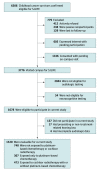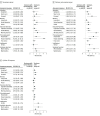Association of Hearing Impairment With Neurocognition in Survivors of Childhood Cancer
- PMID: 32729886
- PMCID: PMC7393588
- DOI: 10.1001/jamaoncol.2020.2822
Association of Hearing Impairment With Neurocognition in Survivors of Childhood Cancer
Abstract
Importance: Despite advancements in cancer therapy and supportive care, childhood cancer survivors remain at risk for chronic morbidities associated with disease and treatment, such as hearing impairment (HI) and neurocognitive deficits. This study, to our knowledge, is the first to objectively measure hearing and neurocognitive function in a large cohort of long-term survivors of childhood cancer stratified by treatment exposures.
Objective: To assess the association of HI with neurocognitive function and the factors in HI that mediate neurocognitive outcomes in survivors of childhood cancer.
Design, setting, and participants: Data analyzed in this cross-sectional study were collected for the period April 25, 2007, to June 30, 2017, from participants in the St. Jude Lifetime Cohort Study (SJLIFE), an ongoing study that quantifies the long-term health outcomes of survivors of childhood cancer. Participants included those treated at St. Jude Children's Research Hospital (Memphis, Tennessee) for childhood cancer who survived 5 or more years after their original diagnosis and who were eligible for audiologic and neurocognitive testing. Hearing outcomes were coded using the Chang Ototoxicity Grading Scale. Data analysis was performed from March 22, 2019, to March 5, 2020.
Main outcomes and measures: Hearing and neurocognitive function. Survivors were grouped by hearing sensitivity (normal hearing [Chang grade 0], mild HI [Chang grades 1a, 1b, and 2a], or severe HI [Chang grade ≥2b]) and stratified by treatment exposure (platinum-only exposure group [treated with cisplatin and/or carboplatin chemotherapy], cochlear radiotherapy [RT] exposure group [treated with cochlear RT with or without platinum-based chemotherapy], or no exposure group [no platinum-based chemotherapy or cochlear RT]). Multivariable log-binomial models were adjusted for age at diagnosis, time since diagnosis, sex, and relevant treatment exposures.
Results: A total of 1520 survivors of childhood cancer were analyzed, among whom 814 were male survivors (53.6%), the median (interquartile range [IQR]) age was 29.4 (7.4-64.7) years, and the median (IQR) time since diagnosis was 20.4 (6.1-53.8) years. Prevalence and risk of severe HI among survivors were higher in survivors in the platinum-only (n = 107 [34.9%]; relative risk [RR], 1.68 [95% CI, 1.20-2.37]) or cochlear RT (n = 181 [38.3%]; RR, 2.69 [95% CI, 2.02-3.57) exposure group compared with those in the no exposure group (n = 65 [8.8%]). Severe HI was associated with deficits in verbal reasoning skills (no exposure group RR, 1.11 [95% CI, 0.50-2.43]; platinum-only exposure group RR, 1.93 [95% CI, 1.21-3.08]; cochlear RT exposure group RR, 2.00 [95% CI, 1.46-2.75]), verbal fluency (no exposure group RR, 1.86 [95% CI, 1.19-2.91]; platinum-only exposure group RR, 1.83 [95% CI, 1.24-2.71]; cochlear RT exposure group RR, 1.45 [95% CI, 1.09-1.94]), visuomotor speed (no exposure group RR, 1.87 [95% CI, 1.07-3.25]; platinum-only exposure group RR, 3.10 [95% CI, 1.92-4.99]; cochlear RT exposure group RR, 1.40 [95% CI, 1.11-1.78]), and mathematics skills (no exposure group RR, 1.90 [95% CI, 1.18-3.04]; platinum-only exposure group RR, 1.63 [95% CI, 1.05-2.53]; cochlear RT exposure group RR, 1.58 [95% CI, 1.15-2.18]), compared with survivors with normal hearing or with mild HI.
Conclusions and relevance: Results of this study suggest that severe HI in childhood cancer survivors is associated with neurocognitive deficits independent of the neurotoxic treatment received. Early screening and intervention for HI may facilitate the development and maintenance of neurocognitive function and identify individuals at risk for impairment.
Conflict of interest statement
Figures


Comment in
-
Seeing (Hearing Loss) With Fresh Eyes.JAMA Oncol. 2020 Sep 1;6(9):1335-1337. doi: 10.1001/jamaoncol.2020.2639. JAMA Oncol. 2020. PMID: 32729928 No abstract available.
References
-
- Howlader N, Noone AM, Krapcho M, et al. SEER Cancer Statistics Review, 1975-2016. Updated April 9, 2020. Accessed February 15, 2020. https://seer.cancer.gov/archive/csr/1975_2016/
MeSH terms
Substances
Grants and funding
LinkOut - more resources
Full Text Sources
Medical
Miscellaneous

